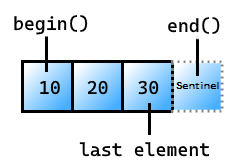filter_view クラス (C++ 標準ライブラリ)
述語と一致しない範囲の要素を除外するビュー。
構文
template<ranges::input_range V, indirect_unary_predicate<iterator_t<V>> Pred>
requires view<V> && is_object_v<Pred>
class filter_view : public view_interface<filter_view<V, Pred>>;
テンプレート パラメーター
V
基になる範囲の型。
Pred
保持する要素を決定する述語の型。
特性の表示
以下の項目の説明については、 View クラスの特性を参照してください。
| 特徴 | 説明 |
|---|---|
| 範囲アダプター | views::filter |
| 基になる範囲 | input_range以上を満たす必要があります |
| 要素の種類 | 基になる範囲と同じ |
| 反復子カテゴリの表示 | input_range、forward_range、または基になる範囲に応じてbidirectional_range |
| サイズ | いいえ |
const対応 |
いいえ |
| 共通範囲 | 基になる範囲が満たされる場合のみ common_range |
| 借用範囲 | 基になる範囲が満たされる場合のみ borrowed_range |
メンバー
| メンバー関数 | 説明 |
|---|---|
| コンストラクターC++20 | ビューを構築します。 |
baseC++20 |
基になる範囲を取得します。 |
beginC++20 |
最初の要素を指す反復子を取得します。 |
endC++20 |
ビューの最後にあるセンチネルを取得します。 |
predC++20 |
削除する要素を決定する述語への参照を取得します。 |
| view_interfaceから継承 | 説明 |
backC++20 |
最後の要素を取得します。 |
emptyC++20 |
ビューが空かどうかをテストします。 |
frontC++20 |
最初の要素を取得します。 |
operator boolC++20 |
ビューが空でないかどうかをテストします。 |
要件
Header: <ranges> (C++20 以降)
名前空間: std::ranges
コンパイラ オプション: /std:c++20 以降が必要です。
コンストラクター
のインスタンスを構築する filter_view
1) constexpr filter_view(V base, P pred);
2) filter_view() requires default_initializable<V> && default_initializable<Pred> = default;
パラメーター
base
基になるビュー。
pred
基になるビューから保持する要素を決定する述語。
テンプレート パラメーターの型の詳細については、「 Template パラメーターを参照してください。
戻り値
filter_view のインスタンス。
解説
filter_viewを作成する最善の方法は、views::filter範囲アダプターを使用することです。 範囲アダプターは、ビュー クラスを作成するための目的の方法です。 独自のカスタム ビューの種類を作成する場合は、ビューの種類が公開されます。
1) 値初期化 filter_viewを作成します。 述語と基になるビューは、既定で初期化可能である必要があります。
2) base ビューとpred述語からfilter_viewを移動します。 baseとpredの両方がstd::move()経由で移動されます。
例: filter_view
// requires /std:c++20 or later
#include <ranges>
#include <iostream>
#include <vector>
void print(auto v)
{
for (auto& x : v)
{
std::cout << x << ' ';
}
std::cout << '\n';
}
int main()
{
std::vector<int> v{0, 1, -2, 3, -4, -5, 6};
auto myView = std::views::filter(v, [](int i) {return i > 0; });
print(myView); // outputs 1 3 6
auto myView2 = v | std::views::filter([](int i) {return i < 3; });
print(myView2); // outputs 0 1 -2 -4 -5
}
1 3 6
0 1 -2 -4 -5
base
基になる範囲を取得します。
// Uses a copy constructor to return the underlying range
constexpr V base() const& requires std::copy_constructible<V>;
// Uses std::move() to return the underlying range
constexpr V base() &&;
パラメーター
ありません。
返品
基になるビュー。
begin
ビューの最初の要素を指す反復子を取得します。
constexpr auto begin();
戻り値
ビューの最初の要素を指す反復子。 ビューに述語がない場合、動作は未定義です。

end
ビューの最後にあるセンチネルを取得します。
constexpr auto end()
戻り値
ビューの最後の要素に続く Sentinel:

pred
ドロップする先頭要素を決定する述語への参照を取得します。
constexpr const Pred& pred() const;
戻り値
述語への参照。
解説
クラスに述語が格納されていない場合、動作は未定義です。
例 pred
// requires /std:c++20 or later
#include <ranges>
#include <iostream>
#include <vector>
int main()
{
std::vector<int> v{0, 1, 2, 3, -4, 5, 6};
auto mv = v | std::views::filter(
[](int i) {return i < 5; }); // keep the elements < 5
std::cout << std::boolalpha << mv.pred()(v[6]); // outputs "false" because v[6] = 6 and 6 is not less than 5 (the predicate)
}